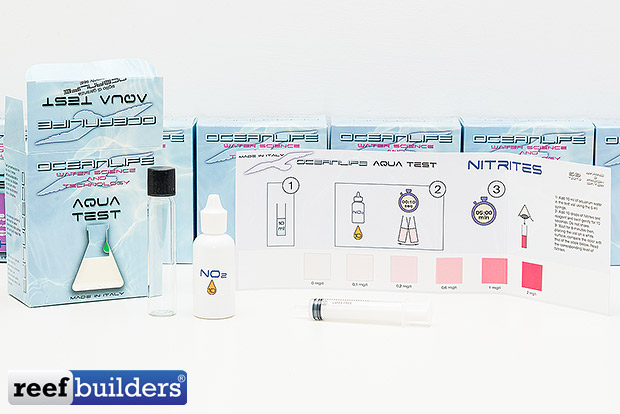Please welcome our newest writer Danilo Ronchi, an Italian reefer who’s an old salt when it comes to writing about marine aquariums.
Some weeks ago Oceanlife presented his new test kit line which we’ll introduce today as the Oceanlife Aqua Test Nitrites. As you can see from the picture the test is composed of a box of generous dimensions that contains the folding carton with the reference colors, a glass test vial, a flask containing the reagent called NO2 and a syringe.
Here below we can see the reference card with instructions in English and designed for each step.
The Oceanlife Nitrite Test Kit is good for 50 measurements, and the scale of detectable nitrite has the following values: 0 – 0.1 – 0.2 – 0.6 – 1 – 2 mg/l. Performing this test is really quite simple. We have to fill the vial with 10 ml of aquarium water, then we have to add 10 drops of reagent gently shake the vial for 10 seconds then let the vial sit for 5 minutes before reading the value.
Reading is done, as usual, from the top, holding the vial on a white card reference, being careful not to make a shadow with the same vial on the card. The test and the identification of the color is rather simple, the problem is that there is little space for white reference between the colored squares. Perhaps it was on purpose that a flat gray color was chosen, but this is quite different from what we expect.
That said, the test is very cheap as it costs 10.08 € in Europe, especially when compared with the Elos test costs 20.25 € and I still think one of the best on the market. In fact, with half the price you get a test that supposedly uses the same reagent, but enough to detect problems in the aquarium. Given the price the value that emerges is very high.
We remember that all tests, although they have a high number of measurements, should be used not more than 6 months from their first use, in order to prevent incorrect storage can ruined the reagents. Considered the 6-month reference period and 50 measurements means that with this test we can make about two reading a week for a period of six months, at a cost of about 20 eurocents per measurement.



